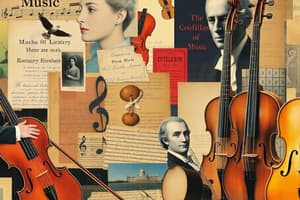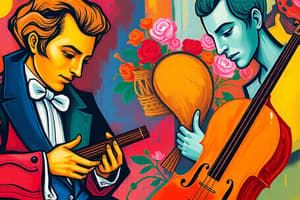Podcast
Questions and Answers
Which musical characteristic is primarily associated with the Middle Ages?
Which musical characteristic is primarily associated with the Middle Ages?
- Dissonance
- Monophonic texture (correct)
- Ornamentation
- Polyphony
What is a key feature of the Renaissance period in music?
What is a key feature of the Renaissance period in music?
- Emotional expression
- Atonality
- Basso continuo
- Word painting in madrigals (correct)
Which instrument became prevalent during the Classical period as a replacement for earlier keyboard instruments?
Which instrument became prevalent during the Classical period as a replacement for earlier keyboard instruments?
- Hurdy-gurdy
- Piano (correct)
- Flute
- Harpsichord
What characterizes the Romantic period in music?
What characterizes the Romantic period in music?
Which composer is associated with the Baroque period?
Which composer is associated with the Baroque period?
What type of musical form saw significant development during the Classical period?
What type of musical form saw significant development during the Classical period?
Which family of instruments expanded significantly in orchestras during the Romantic era?
Which family of instruments expanded significantly in orchestras during the Romantic era?
What technological advancement is associated with 20th-century music?
What technological advancement is associated with 20th-century music?
Flashcards
String Instrument
String Instrument
A type of musical instrument that produces sound using a vibrating string. Examples include the violin, cello, and guitar.
Monophony
Monophony
A musical period marked by the use of a single melody line, without harmony, often used in religious music.
Baroque Era
Baroque Era
This era in music is characterized by its complex, layered melodies and harmonies. Think of the music of Bach, Handel, and Vivaldi.
Classical Era
Classical Era
Signup and view all the flashcards
Word Painting
Word Painting
Signup and view all the flashcards
Woodwind Instrument
Woodwind Instrument
Signup and view all the flashcards
Brass Instrument
Brass Instrument
Signup and view all the flashcards
Romantic Era
Romantic Era
Signup and view all the flashcards
Study Notes
Identifying Musical Time Periods
-
Middle Ages (500-1400): Characterized by monophonic texture (e.g., Gregorian chant), sacred music, and modal melodies. Composers include Hildegard von Bingen and Guillaume de Machaut. Instrumentation primarily involved voices (unaccompanied) and early instruments like the hurdy-gurdy.
-
Renaissance (1400-1600): Featured polyphony, increased use of harmony, and word-painting in madrigals. Key composers are Josquin des Prez, Palestrina, and Thomas Tallis. Instrumentation included the lute, viol, harpsichord, and small choirs.
-
Baroque (1600-1750): Known for ornamentation, contrasts between loud and soft (dynamics), and the use of basso continuo. Prominent composers include Johann Sebastian Bach, George Frideric Handel, and Antonio Vivaldi. Instrumentation involved harpsichord, strings, woodwinds, organ, and small orchestras.
-
Classical (1750-1820): Emphasized clarity, balance, symmetry, and the development of sonata form. Notable composers are Wolfgang Amadeus Mozart, Joseph Haydn, and Ludwig van Beethoven. The piano replaced the harpsichord, and string quartets and full orchestras became common.
-
Romantic (1820-1900): Characterized by emotional expression, expanded orchestras, and program music. Composers like Franz Schubert, Johannes Brahms, and Richard Wagner are associated with this period. Instrumentation involved larger orchestras, with a strong emphasis on strings, brass, and piano.
-
20th Century (1900-Present): Marked by experimentation, dissonance, atonality, and the use of new technologies. Examples of composers are Igor Stravinsky, Arnold Schoenberg, and John Cage. Instrumentation included electronic instruments, percussion, and unconventional ensembles.
Instrument Families and Usage
-
Strings: Violin, viola, cello, double bass, and harp are frequently used throughout musical periods, with prominent roles in Baroque and Romantic periods.
-
Woodwinds: Flute, oboe, clarinet, and bassoon are key instruments in Classical and Romantic orchestras.
-
Brass: Trumpet, trombone, French horn, and tuba. The brass section of orchestras expanded dramatically during the Romantic era.
-
Percussion: Timpani, snare drum, xylophone, and cymbals, significantly important in 20th-century music.
-
Keyboard: Harpsichords (Baroque), pianos (Classical and onwards), and organs (Renaissance and Baroque) are important keyboard instruments.
Genres and Forms
-
Middle Ages: Gregorian chant, motet.
-
Renaissance: Madrigal, mass.
-
Baroque: Concerto, fugue, oratorio, opera.
-
Classical: Symphony, string quartet, sonata.
-
Romantic: Lieder (art songs), symphonic poem, grand opera.
-
20th Century: Serialism, minimalism, electronic music.
Key Terms to Memorize
- Texture: Monophonic, polyphonic, homophonic
- Tonality: Major, minor, atonal
- Form: Binary, ternary, rondo, sonata
- Orchestration: How instruments combined in an ensemble
- Basso Continuo: Baroque accompaniment
Vocal Types and Genres
- Voice Types: Soprano, mezzo-soprano, alto, tenor, baritone, bass.
- Genres: Opera, cantata, mass, oratorio, art songs.
Studying That Suits You
Use AI to generate personalized quizzes and flashcards to suit your learning preferences.




